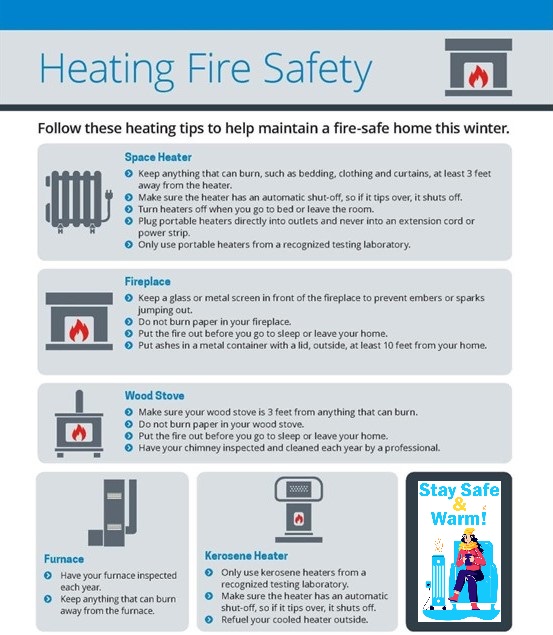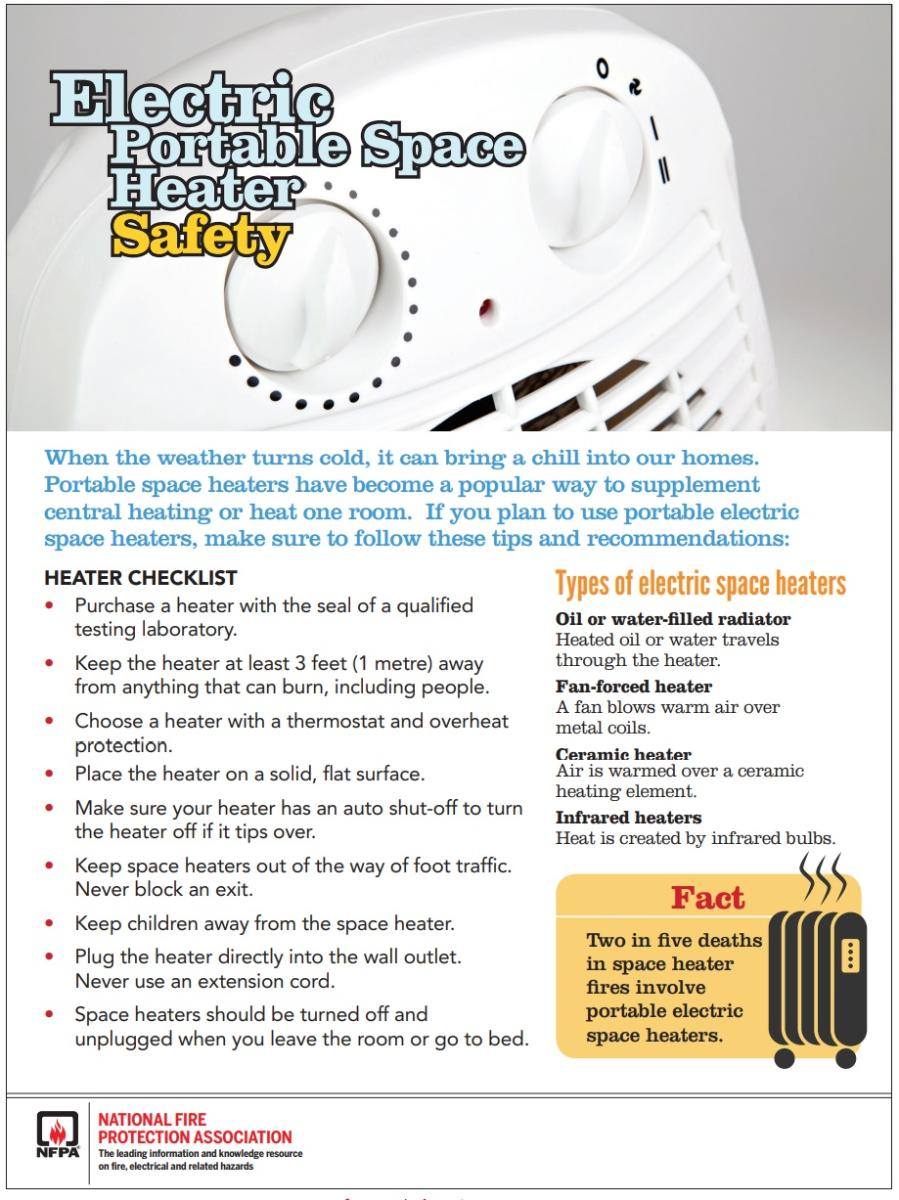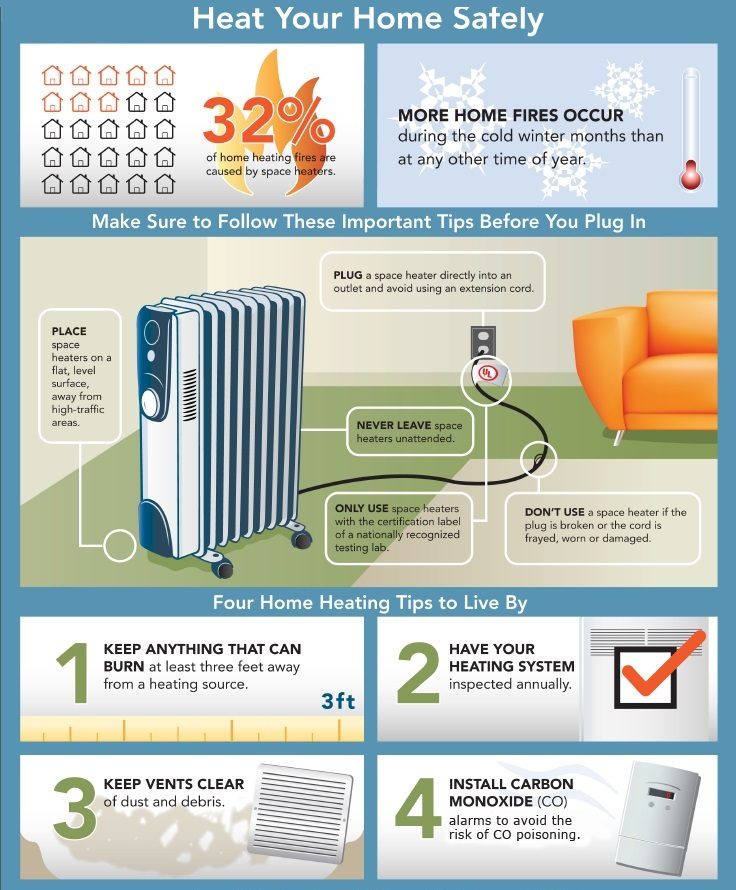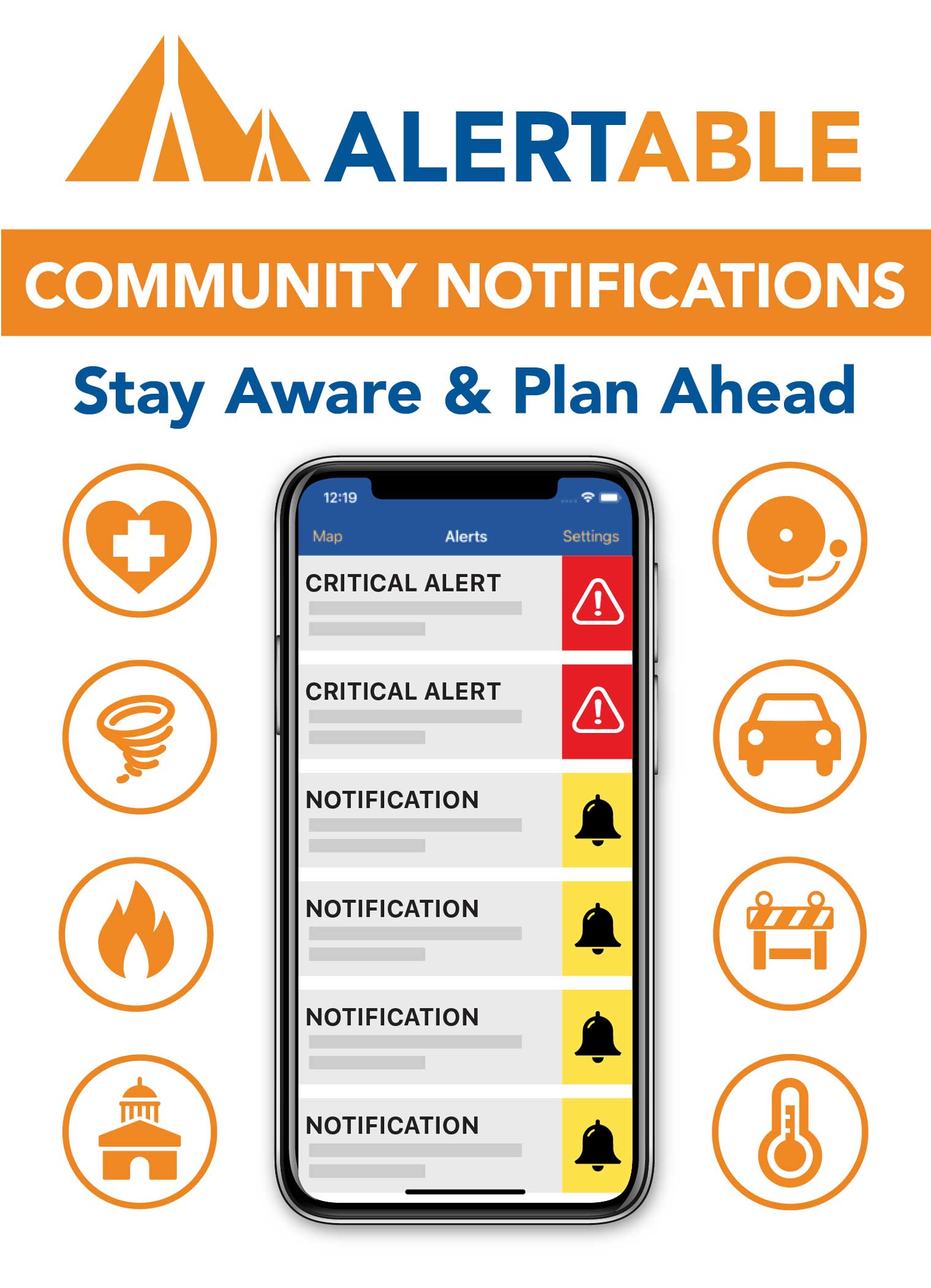Extreme Cold
Extreme Cold
Extreme Cold in Annapolis County: Prepare and Stay Safe Winters in Annapolis County, Nova Scotia, can be harsh, with temperatures frequently dropping well below freezing. Residents face these conditions every year while commuting, working outdoors, or enjoying winter activities. However, extreme cold can quickly become dangerous—and even life-threatening—if precautions aren’t taken.
Winters in Annapolis County, Nova Scotia, can be harsh, with temperatures frequently dropping well below freezing. Residents face these conditions every year while commuting, working outdoors, or enjoying winter activities. However, extreme cold can quickly become dangerous—and even life-threatening—if precautions aren’t taken.
Exposure to extreme cold can lead to serious health risks, such as frostbite and hypothermia. Frostbite causes damage to the skin and underlying tissue, while hypothermia occurs when the body’s core temperature drops to a dangerously low level. Both conditions can become life-threatening without proper care. Infants, the elderly, and individuals without adequate clothing or shelter are especially vulnerable.
In Nova Scotia, extreme cold often means temperatures plunging far below freezing, combined with strong winds that amplify the cold through wind chill. These conditions can cause pipes to freeze and burst in homes that are not properly insulated or heated, creating additional challenges for residents.
Preparing for extreme cold is essential to staying safe. By understanding the risks and taking simple preventative measures, you can protect yourself, your loved ones, and your property from the dangers of Annapolis County’s winter weather.
Graphic Source:http://www.freepik.com>Designed by brgfx)
Wind Chill and its hazards
WIND CHILL AND ITS HAZARDS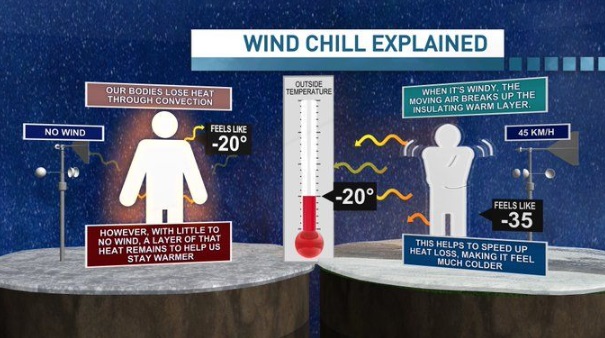
In Canada, Environment and Climate Change Canada (ECCC) provides a Wind Chill Temperature Index to help estimate the effects of wind chill based on temperature and wind speed. The guidelines are designed to protect all individuals, including the young and elderly, who are exposed to the cold. Keep in mind that cold stress, including frostbite and hypothermia, can be life-threatening, especially for vulnerable groups.
It’s important to know that the impact of wind chill can vary by location and situation. In the northern parts of Canada, extreme cold often means temperatures well below zero, which can pose serious health risks. As wind speeds increase, it becomes even more critical to protect yourself from the cold.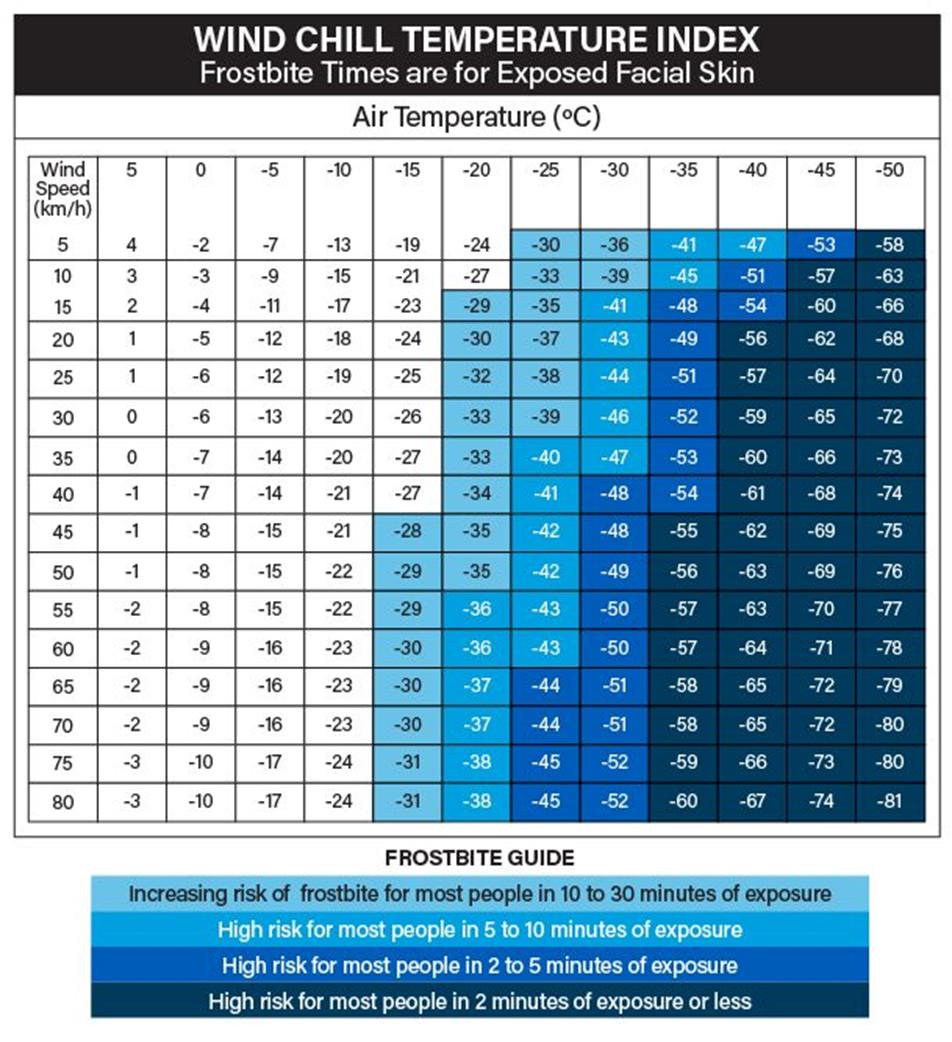
Wind Chill Hazards and What to Do
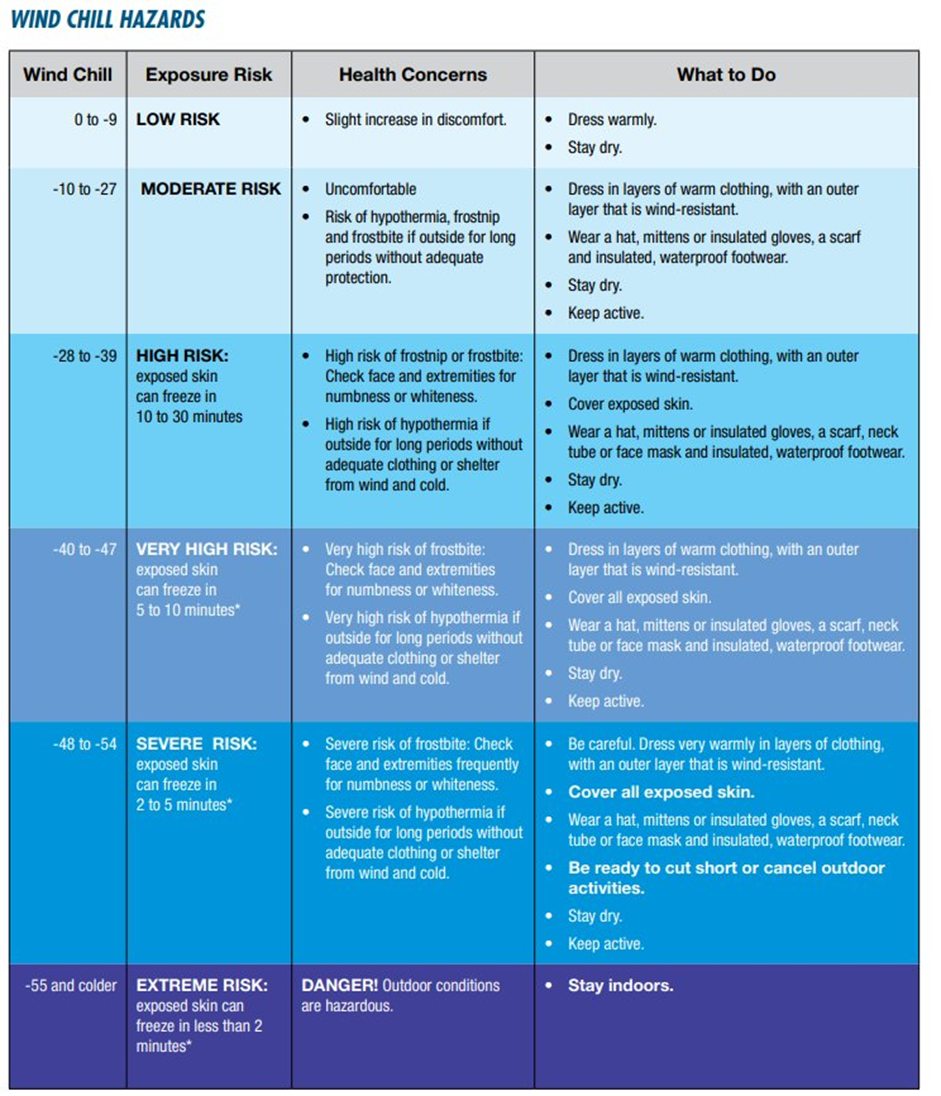
For detailed information on wind chill, its risks, and how to protect yourself, visit Get Prepared, where you can learn about the Wind Chill Index, its effects, cold weather safety, and more.
https://www.getprepared.gc.ca/cnt/hzd/xtrm-cld-en.aspx
Staying Safe in Extreme Cold
Understanding Wind Chill
The best way to avoid the dangers of wind chill is to check the weather forecast before heading outside and to dress appropriately. Wind chill values below -27 increase the risk of frostbite significantly. Environment Canada bases its wind chill forecasts on conditions experienced in open areas, so taking shelter from the wind can greatly reduce this effect. However, the temperature alone can still cause discomfort and health risks.
Who is Most at Risk?
While anyone unprepared for the cold is at risk, some groups are more vulnerable to frostbite and hypothermia:
- Homeless individuals
- Outdoor workers
- People in poorly insulated homes
- Those with medical conditions such as diabetes or circulatory issues
- Winter sport enthusiasts
- Infants under one year old
- Seniors aged 65 and older
How to Prepare for Extreme Cold Events
Emergency Kits and Plans:
- Prepare an emergency kit with items such as food, water, flashlights, batteries, blankets, and a first-aid kit.
- Create a household emergency plan that considers the needs of all members, including children, older adults, and pets.
Clothing:
- Wear insulated jackets, waterproof boots, warm socks, gloves or mittens, a toque, and a scarf. Dressing in layers helps trap heat.
Home Preparation:
- Ensure your heating system is in good working order and seal any drafts to retain heat.
- Install certified carbon monoxide alarms with battery backup near sleeping areas.
- Consider a backup heat source, such as a generator or a non-electric fireplace.
Vehicle Preparation:
- Keep a car emergency kit with blankets, jumper cables, and winter supplies.
- Maintain a full gas tank and use winter tires for safer driving.
During an Extreme Cold Event
- Take shelter immediately if you experience numb extremities or other signs of exposure.
- Delay travel or outdoor activities until conditions improve.
- Never use fuel-burning devices indoors, such as BBQs or generators, to avoid carbon monoxide poisoning. Operate generators at least 20 feet from your home, directing exhaust away from windows and doors.
- Run a trickle of water to prevent pipes from freezing.
After an Extreme Cold Event
- Check for signs of cold-related illnesses, as symptoms can appear weeks later.
- Ensure vulnerable neighbors, such as older adults, have sufficient supplies and are warm enough.
For more information visit: Extreme cold - Canada.ca
Cold Weather Injuries
COLD WEATHER INJURIESCold injuries, such as frostbite and hypothermia, can be dangerous or life-threatening. Extremities like the ears, nose, fingers, and toes lose heat the quickest, making them vulnerable to frostnip or frostbite. In extreme cold or prolonged exposure, the body’s core temperature can drop, leading to hypothermia.
While anyone who isn't dressed warmly is at risk in cold weather conditions, some are at greater risk than others for frostbite and hypothermia:
- homeless people
- outdoor workers
- people living in homes that are poorly insulated (with no heat or no power)
- people with certain medical conditions such as diabetes, peripheral neuropathy, and diseases affecting the blood vessels
- people taking certain medications including beta-blockers
- winter sport enthusiasts
- infants (under 1 year)
- seniors (65 years or older)
Hypothermia occurs when the body’s temperature drops below 37ºC, causing shivering, confusion, and difficulty moving. If untreated, it can lead to unconsciousness or cardiac arrest. Seek immediate medical help, warm the person gradually, and remove wet clothing.
Frostnip is a mild form of frostbite where only the skin freezes, causing pain, tingling, and a white or yellowish appearance. Warm the area gradually with body heat or warm water, but avoid rubbing or applying direct heat.
Frostbite involves freezing of both the skin and underlying tissues, resulting in numbness, white waxy skin, and hardening. It requires medical attention, and the affected area should be warmed gradually using body heat or warm water, avoiding direct heat. Do not rub the area, as this can cause further damage.
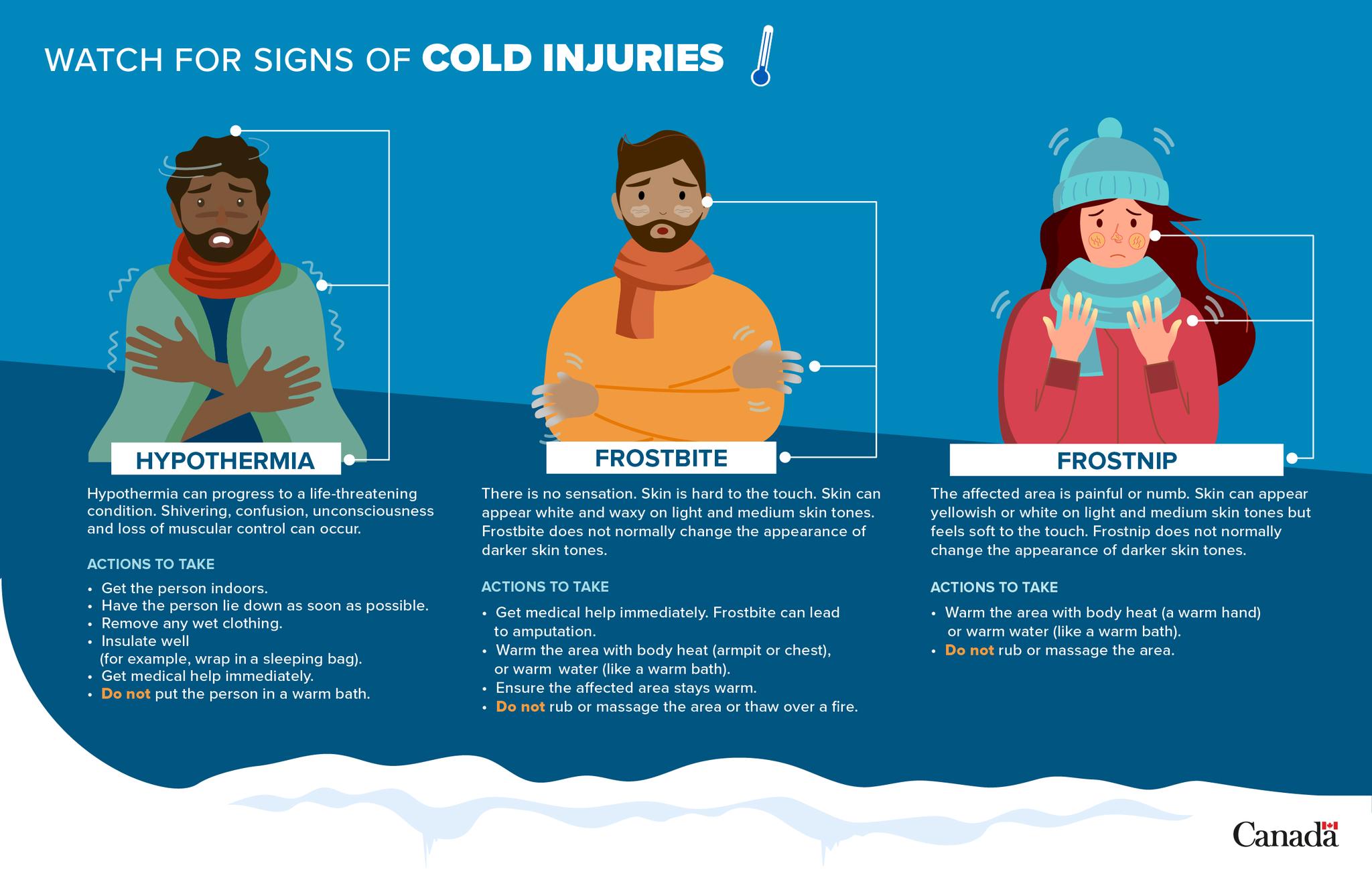 For more information visit: https://www.canada.ca/.../environment/extreme-cold.html
For more information visit: https://www.canada.ca/.../environment/extreme-cold.html(Graphic Source: Health Canada)
Protecting your house during extreme cold
Protecting your house during extreme coldExtreme cold temperatures in Annapolis County can pose significant risks to your home, particularly your plumbing. Frozen pipes are not just an inconvenience—they can lead to costly repairs if they burst. Taking steps to prevent pipes from freezing and knowing what to do if they do freeze can save you time, money, and stress.
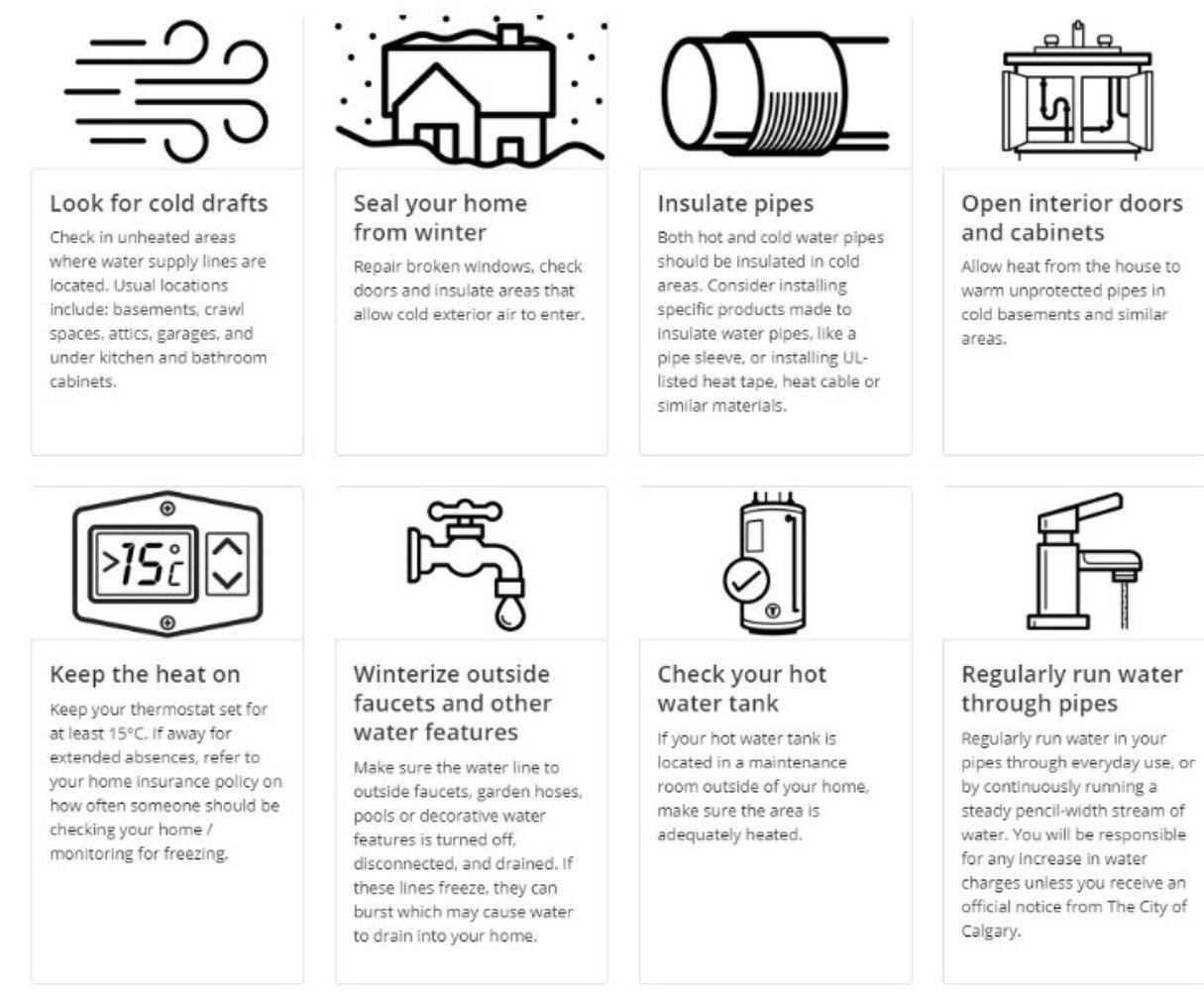
Why Frozen Pipes Are a Problem
When water freezes, it expands. This expansion creates tremendous pressure that can cause pipes—whether metal or plastic—to crack or burst. Pipes in unheated or poorly insulated areas, such as basements, garages, attics, and exterior walls, are especially vulnerable during cold snaps.

How to Prevent Pipes from Freezing
Before freezing temperatures arrive, take these steps to protect your pipes:
- Insulate Vulnerable Areas: Add insulation to attics, crawl spaces, basements, and any areas where water supply lines are exposed. Use pipe sleeves or UL-listed heat cables for additional protection. Even a layer of newspaper can provide some insulation.
- Drain Outdoor Water Lines: Remove, drain, and store garden hoses. Drain and shut off water supply lines for sprinklers and pools, following manufacturer instructions. Leave outdoor faucets slightly open to allow any remaining water to expand safely.
- Seal Gaps and Cracks: Close off drafts around windows, doors, and exterior walls to keep indoor areas warmer.
During freezing weather:
- Keep Garage Doors Closed: This is especially important if water supply lines run through the garage.
- Open Cabinet Doors: Allow warm air to circulate around plumbing under sinks, particularly those on exterior walls. Move any harmful chemicals out of children’s reach.
- Run a Trickle of Water: Letting water flow through faucets can help prevent freezing. Even a small trickle can reduce pressure and prevent ice from forming.
- Maintain a Consistent Temperature: Keep your thermostat set to the same temperature day and night. If you’re leaving home, set the heat no lower than 15°C (59°F).
What to Do If Your Pipes Freeze
If you suspect a pipe has frozen, act quickly to minimize damage:
- Turn On the Faucet: Even a slow trickle can help melt ice in the pipe.
- Apply Heat: Use an electric heating pad, hair dryer, or portable space heater to warm the frozen section. Avoid open flames, as they can cause fires or damage pipes.
- Check Other Faucets: If one pipe has frozen, others may have as well.
- Call a Professional: If you can’t locate or thaw the frozen pipe, contact a licensed plumber.
Long-Term Solutions for Extreme Cold
To reduce the risk of frozen pipes in the future, consider:
- Insulating your home’s vulnerable areas.
- Sealing drafts and air leaks.
- Relocating exposed pipes to warmer areas of the home.
For more information visit: Keeping the Heat In
Taking proactive steps now can help you avoid the stress and expense of frozen or burst pipes during Annapolis County’s cold winter months. Stay prepared, protect your home, and enjoy peace of mind this winter.
Extreme Cold care for your Pets
Keep Your Pets Safe and Warm This Winter
Winter weather can be tough on our furry friends. As temperatures drop, it’s important to take extra precautions to keep your pets safe and comfortable. Here are some simple tips to ensure your pets stay warm this winter:
Limit Outdoor Time
Cold weather can be dangerous for pets. Limit their time outdoors, especially during extreme cold snaps. If it’s too cold for you, it’s likely too cold for them.
Dress for the Weather
Short-haired pets may benefit from a cozy sweater or coat when going outside. Make sure it fits well and doesn’t restrict movement.
Protect Their Paws
Snow, ice, and salt can irritate your pet’s paws. Wipe their paws clean after walks and consider using pet-safe booties to protect them.
Provide Warm Shelter
If your pet spends time outside, ensure they have a warm, insulated shelter. The shelter should be dry, out of the wind, and stocked with blankets or straw for added warmth.
Watch Out for Frostbite
Keep an eye out for signs of frostbite, such as pale or cold ears, tail tips, or paws. If you suspect frostbite, contact your veterinarian immediately.
Keep Them Hydrated
Even in winter, pets need plenty of fresh water. Check outdoor water bowls often to ensure they haven’t frozen.
Never Leave Pets in the Car
Just as cars can overheat in summer, they can become dangerously cold in winter. Never leave your pet alone in a car during freezing weather.
Prepare a Pet Emergency Kit
Having a 72-hour emergency preparedness kit for your pets is essential for at home and on the road. Include items such as:
- Food and water for three days
- Collapsible bowls
- A leash and harness
- Blankets for warmth
- Any necessary medications
- Waste bags for cleanup
- A favorite toy to help reduce stress
By following these tips, you can help your pets enjoy a safe and cozy winter season.
For more information visit:
- Nova Scotia SPCA
- Canadian Veterinary Medical Association
- Disaster Animal Response Team of Nova Scotia
Stay Informed About Forecast Extreme Winter Weather
Stay Informed
Stay connected to reliable weather alert services to receive updates on weather conditions:- WeatherCAN app provides local weather alert notifications
- Follow Annapolis REMO on social media with Facebook and X for weather alerts and forecast extreme cold weather, storms, and more
- Annapolis REMO Emergency Alerts from Alertable
- Weather information including public weather alerts across Canada
- Weatheradio network hosts a listing of radio weather broadcast frequencies by province or territory
- Hello Weather provides forecasts, conditions, and other weather information by telephone
- Local radio and television broadcasts will help you stay up to date with the latest local weather information
By staying prepared and informed, you can protect yourself and others from the risks of extreme cold weather. Annapolis County residents are no strangers to winter, but with a proactive approach, you can embrace the season safely and comfortably.
Heat Your Home Safely This Winter
Heat Your Home Safely This WinterWinter weather brings the need to keep your home warm, but safety should always come first. Space heaters, fireplaces, and wood stoves can provide extra warmth, but improper use can lead to serious hazards. Space heaters, in particular, are a leading cause of home heating fires.
To keep your household safe:
- Always place heaters on a flat, stable surface, away from flammable items like curtains or furniture.
- Never leave heating equipment unattended.
- Clean chimneys regularly to prevent blockages or fire risks.Have your chimney cleaned and inspected annually. Use a sturdy screen to catch sparks and prevent embers from escaping.
- Use only space heaters certified by nationally recognized testing labs, and avoid damaged cords or plugs.
- Install and maintain carbon monoxide detectors to guard against dangerous situations.
- Never use ovens, grills, or outdoor heaters to heat your home.
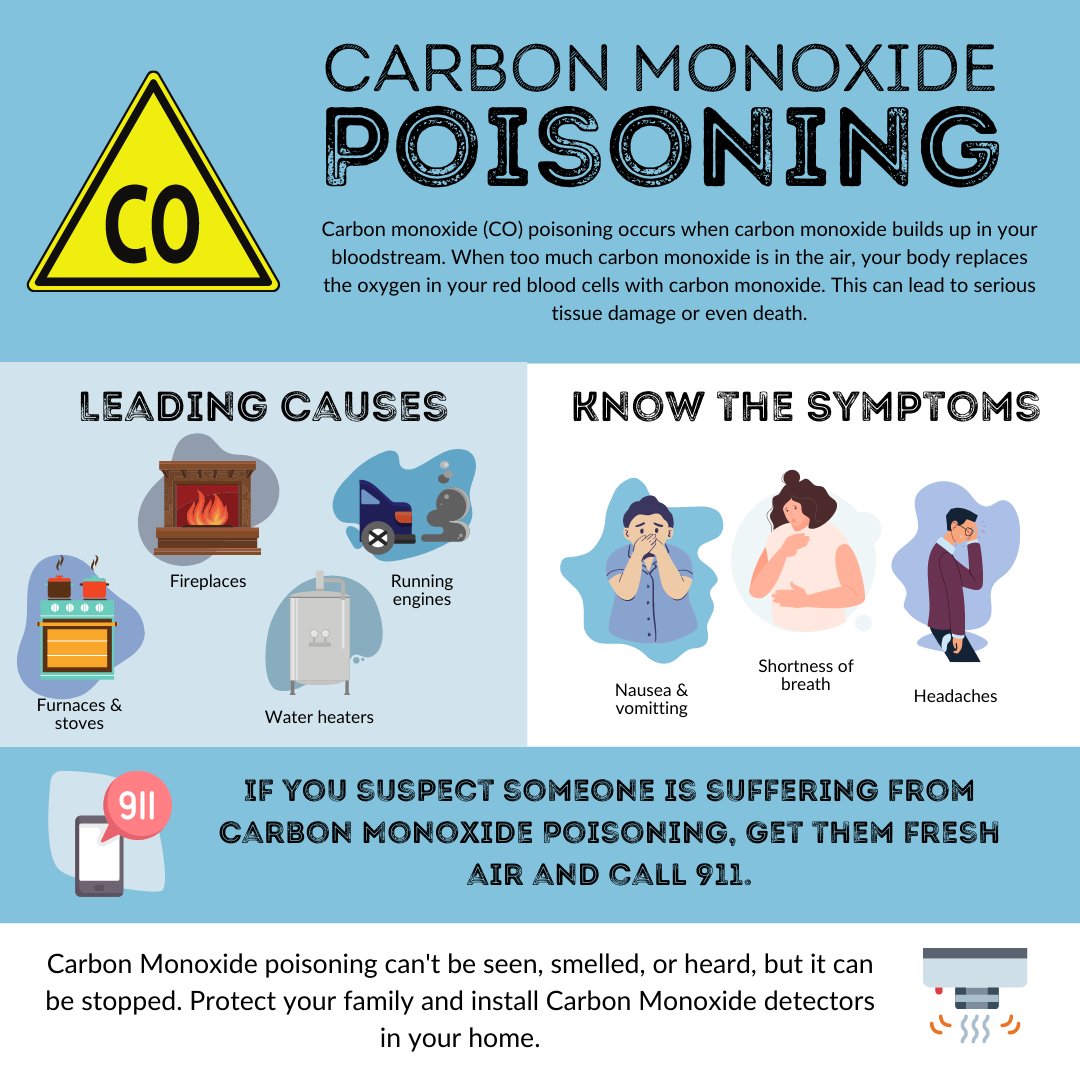
SPACE HEATER SAFETY
Key Facts
- Space heaters cause 32% of home heating fires.
- The winter months have the highest number of home fires compared to any other season.
Tips for Safe Space Heater Use
- Position Carefully: Place space heaters on a flat, stable surface, away from high-traffic areas to prevent tipping.
- Plug Directly Into the Wall: Avoid using extension cords, as they can overheat—always plug heaters directly into a wall outlet.
- Turn It Off When Unattended: Never leave a space heater running when you leave the room or go to sleep.
- Check Certifications: Use only space heaters certified by nationally recognized testing laboratories.
- Inspect Before Use: Do not use a space heater with damaged cords or plugs.
General Home Heating Safety Tips
- Keep Combustibles Away: Ensure a minimum of three feet between heat sources and flammable items like curtains, furniture, or clothing.
- Schedule Annual Inspections: Have your heating system inspected yearly to confirm it’s operating safely.
- Clear Vents: Regularly clean vents and keep them free of dust or blockages to improve efficiency and safety.
- Install Carbon Monoxide Detectors: Protect your household from carbon monoxide poisoning by installing alarms throughout your home.
